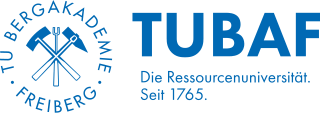
The Technische Universität Bergakademie Freiberg is a public university of technology with 3,471 students in the city of Freiberg, Saxony, Germany. The university's focuses are exploration, mining & extraction, processing, and recycling of natural resources & scrap, as well as developing new materials and researching renewable energies. It is highly specialized and proficient in these fields.
In mathematics and abstract algebra, a Boolean domain is a set consisting of exactly two elements whose interpretations include false and true. In logic, mathematics and theoretical computer science, a Boolean domain is usually written as {0, 1}, or
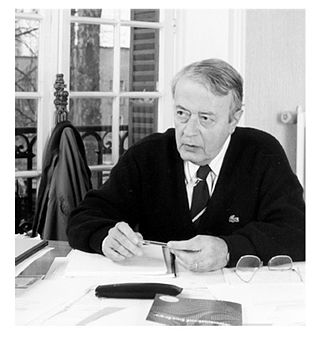
Georges François Paul Marie Matheron was a French mathematician and civil engineer of mines, known as the founder of geostatistics and a co-founder of mathematical morphology. In 1968, he created the Centre de Géostatistique et de Morphologie Mathématique at the Paris School of Mines in Fontainebleau. He is known for his contributions on Kriging and mathematical morphology. His seminal work is posted for study and review to the Online Library of the Centre de Géostatistique, Fontainebleau, France.
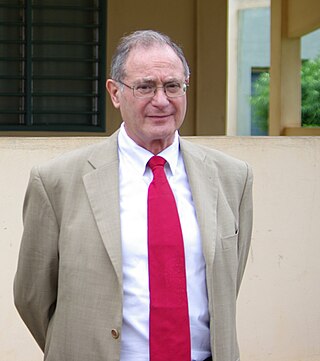
Jean Paul Frédéric Serra is a French mathematician and engineer, and known as one of the co-founders of mathematical morphology.

A scientific collection is a collection of items that are preserved, catalogued, and managed for the purpose of scientific study.

The International Association for Mathematical Geosciences (IAMG) is a nonprofit organization of geoscientists. It aims to promote international cooperation in the application and use of mathematics in geological research and technology. IAMG's activities are to organize meetings, issue of publications on the application of mathematics in the geological sciences, extend cooperation with other organizations professionally concerned with applications of mathematics and statistics to the biological sciences, earth sciences, engineering, environmental sciences, and planetary sciences. IAMG is a not for profit 501(c)(3) organization.
The Georges Matheron Lecture Series is sponsored by the International Association for Mathematical Geosciences (IAMG) to honor the legacy of the French engineer Georges François Paul Marie Matheron, known as the founder of geostatistics and a co-founder of mathematical morphology. The Georges Matheron Lecture is given by a scientist with proven research ability in the field of spatial statistics or mathematical morphology. It is presented annually if an eligible and worthy nominee is found. The first recipient of the award was Jean Serra, for a long time a scientists with the Centre of Mathematical Morphology, Fontainebleau. Serra delivered the first lecture at the IAMG conference in Liège, Belgium in 2006. The IAMG Lectures Committee seeks nominations and makes the selection.
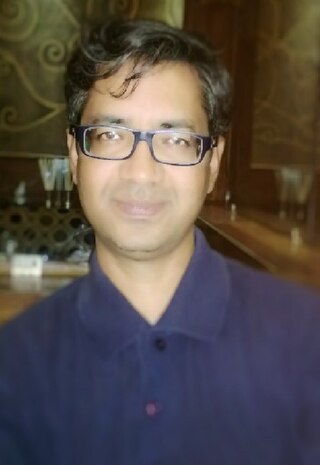
Behara Seshadri Daya Sagar also known as B. S. Daya Sagar is an Indian mathematical geoscientist specializing in mathematical morphology. He is a professor of computer science at the Indian Statistical Institute, Bangalore. He is known as a specialist in mathematical morphology, fractal geometry. chaos theory, and their applications in geophysics, geographical information science, and computational geography. The Indian Geophysical Union awarded him the Krishnan Medal in 2002. He is the first Asian to receive the Georges Matheron Lectureship in 2011. In 2018, he received the IAMG Certificate of Appreciation by the International Association for Mathematical Geosciences for his work on the Handbook of Mathematical Geosciences. In 2020, Sagar was selected as an IEEE Distinguished Lecturer (DL) to represent the IEEE Geoscience and Remote Sensing Society. He, with Frits Agterberg, Qiuming Cheng, and Jennifer McKinley, led the monumental project on the Encyclopedia of Mathematical Geosciences to the completion. The first edition of two-volume 1756-page Encyclopedia of Mathematical Geosciences was published on 21 June 2023 by Springer International Publishers.
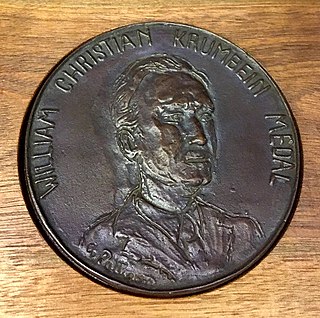
The William Christian Krumbein Medal is the highest award given alternate years by the International Association for Mathematical Geosciences (IAMG) to senior scientists for career achievement, which includes (a) distinction in application of mathematics or informatics in the earth sciences, (b) service to the IAMG, and (c) support to professions involved in the earth sciences. There is no stipulated preference for fields of application within the earth sciences. The William Christian Krumbein Medal, named after William Christian Krumbein, was established in 1976.
The IAMG Distinguished Lectureship is a special lecture series established in the year 2002 by the International Association for Mathematical Geosciences (IAMG). Each year IAMG selects IAMG Distinguished Lecturer, who is an outstanding individual with (i) demonstrated ability to communicate mathematical concepts to general geological audience, (ii) a clear enthusiasm for mathematical geology, (iii) recognition fork in their field, and (iv) established skill in working with individuals and in group discussions on geological problems. The selected IAMG Distinguished Lecturer must be ready to travel and to (i) Prepare and present a lecture suitable for a general geological audience, (ii) Prepare and present one or two lectures on a more specialized topic, and Interact and hold discussions with individuals, both professionals and students, on applications of mathematical geology to local problems of interest.
The Andrei Borisovich Vistelius Research Award is presented biennially by the International Association for Mathematical Geosciences (IAMG) to one male and one female early-career scientist for promising contributions in research in the fields of mathematical geosciences or geoinformatics. A recipient should be either (a) 35 years or younger at the end of the calendar year when selected for the award or (b) within seven years of the awarding of his or her highest degree. These time limits can be extended for up to two years to address circumstances which have interrupted the nominee’s career. This award is named after Andrei Borisovich Vistelius, and was established in 1981.

Vera Pawlowsky-Glahn is a Spanish-German mathematician. From 2000 till 2018, she was a full-time professor at the University of Girona, Spain in the Department of Computer Science, Applied Mathematics, and Statistics. Since 2018 she is emeritus professor at the same university. She was previously an associate professor at Technology University in Barcelona from 1986 to 2000. Her main areas of research interest include statistical analysis of compositional data, algebraic-geometric approach to statistical inference, and spatial cluster analysis. She was the president of the International Association for Mathematical Geosciences (IAMG) during 2008–2012. IAMG awarded her the William Christian Krumbein Medal in 2006 and the John Cedric Griffiths Teaching Award in 2008. In 2007, she was selected IAMG Distinguished Lecturer.
During the 6th International Workshop on Compositional Data Analysis in June 2015, Vera was appointed president of a commission to formalize the creation of an international organization of scientists interested in the advancement and application of compositional data modeling.

Jef Caers, born in Belgium, is an academic working as a Professor at the School of Earth, Energy & Environmental Sciences, Stanford University. He was awarded the Andrei Borisovich Vistelius Research Award and the William Christian Krumbein Medal by the International Association for Mathematical Geosciences in 2001 and 2014 respectively. He is Editor-in-Chief of Computers & Geosciences.

Eric Christopher Grunsky is a Canadian mathematical geoscientist specialized in statistical petrology. Grunsky received the Felix Chayes Prize in 2005 from the International Association for Mathematical Geosciences and served as Editor-in-Chief for the journal Computers & Geosciences from 2006-2011. He was awarded the Krumbein Medal in 2012 by the International Association for Mathematical Geosciences. He is currently serving International Association for Mathematical Geosciences (IAMG) as its appointed Secretary General.

Alfred Emil Richard Kneschke was a German mathematician, engineer and university lecturer. During the World War II, Kneschke managed the Referat IV, Section II of the Wehrmacht Signals intelligence organization General der Nachrichtenaufklärung until November 1944, working on cryptanalysis and decoding of British, USA, French and Balkan cipher systems. From Nov 1944, he worked in the OKW/Chi cipher bureau as a cryptanalyst.
Heinrich Friedrich Gretschel was a German mathematician and scientist.
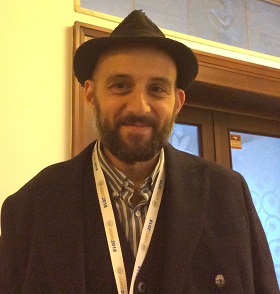
Raimon Tolosana-Delgado is currently working at Helmholtz-Institut Freiberg für Ressourcentechnologie, Germany. Tolosana-Delgado received the Felix Chayes Prize in 2013, and the Andrei Borisovich Vistelius Research Award in 2007, from the International Association for Mathematical Geosciences. He is an elected Executive Vice President of the International Association for Mathematical Geosciences

Mary Hegeler Carus was an American engineer, editor and entrepreneur. In 1882 she was the first woman to graduate in engineering from the University of Michigan.













